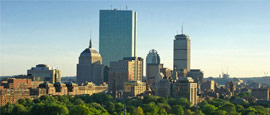The ‘Tea Party' was an act of rebellion against British rule and in particular against new taxes, imposed on, among other commodities, tea. The protest took place on 16 December 1773. A group of Bostonians, disguised as Mohawk Indians, boarded the tea-clipper Beaver and threw all of its cargo into the harbour waters. Visitors can discover the full story on-board a full-size replica ship, Beaver II.
Things to see in Boston
Tourist offices
Address: 136 Blackstone Street, 5th Floor, Boston, MA 02109, United States
Tel: +1 617 973 8500.
www.mass-vacation.com/
Address: 2 Copley Place, Suite 105, Boston, MA 02116, United States
Tel: +1 617 536 4100.
Opening Hours:
Mon-Fri 0830-1700.
www.bostonusa.comTourist information booths are located at Boston Common and the Prudential Center, 101 Huntington Avenue.
The CityPass (www.citypass.com) offers up to 47% off combined prices to must-see attractions - Museum of Science, Museum of Fine Arts, New England Aquarium, Skywalk Observatory and the Harvard Museum of Natural History or the Old State House. It lasts for nine days and can be purchased from the attractions on the day or online in advance.
The GoBoston Card (www.gobostoncard.com) offers a one- to multi-day card for free admissions to over 50 attractions, plus shopping, restaurant and lodging discounts.
The Greater Boston Convention & Visitors Bureau's website (www.bostonusa.com) lists further deals, including BostonUSA Specials discount coupons and the Family Friendly Pass.
The Harvard Art Museum, which is housed in a state-of-the-art structure designed by architect Renzo Piano, brings together the 250,000 strong collection of the Fogg, Busch-Reisinger and Arthur Sackler museums, which cover European, Asian, Islamic and Indian art. Outside the Yard, the Museum of Natural History is renowned for its display of authentic-looking, hand-blown glass flowers, while the Semitic Museum has a collection of Middle Eastern art and archaeology. Finally, the Peabody Museum of Anthropology and Ethnology covers exhibits of archaeology and cultures from six continents.
The MFA’s impressive collection spans from 6,000BC to the contemporary works of such artists as Andy Warhol and Rineke Dijkstra. Of note is the museum's Asian collection. Its Temple Room has the finest Buddhist collection outside Japan, and its small Impressionism gallery displays significant works by Renoir, Monet, Cassatt, Degas, Pissaro and Cezanne.
Boston’s amazing Museum of Science has more than 600 interactive exhibits exploring technology, computers, complex systems, energy, maps, models and dinosaurs. Aside from the world’s largest lightening bolt generator, the museum also houses the Charles Hayden Planetarium and a Discovery Centre dedicated to hands-on fun for even the youngest enquiring minds.
Considered one of the top three children's museums in the country, this interactive, educational space will keep kids aged 10 and under amused for hours. Focusing on arts, culture and science highlight exhibits include intercultural immersion experiences, a three-story climbing structure and a hands-on construction site. In nice weather there’s also ample space to play outside in the waterside park.
On a sunny day, the Boston Harbor Tour is a pleasant way to while away three and a half hours. The 45-minute ride to Little Brewster Island is a lesson in history, lighthouses and shipwrecks. Along the way is Spectacle Island, with a past that runs the gamut from a home to an 18th-century quarantine hospital, a resort and even a garbage dump.
Other interesting islands in the 34-island national park area include Long Island (not open to the public) and Georges Island. Its Fort Warren served as a Civil War jail. The first US lighthouse (1716) was built on Little Brewster Island. Although the British burned it when they left, it was rebuilt in 1783. Visitors can climb its 76 winding steps and two ladders for an amazing view of the Boston skyline.
New England's largest Afro-American museum is housed in two 18th century buildings: the African Meeting House, the country's oldest black church and meeting house, and Abiel Smith School, the country's first school for African Americans. The museum is also a source of information about and the final destination of the Black Heritage Trail.
Step inside and discover the world of the underwater. A spiral ramp ascends four floors while circling a giant saltwater tank and passing a critical care ward for sick animals, a touch tank, penguins, a coral reef, sharks, eels, turtles and lots of other creatures of the deep which serve to awe and educate visitors. Daily programs include penguin presentations, tank dives and seal training exhibits. There is also an IMAX theatre featuring films with an aquatic theme.
Representing the Jews killed in the Holocaust are six glass columns, each etched with a million names. During the winter, smoke rises from each, a grim reminder of the mass murders committed and the concentration camp ovens. The memorial is located on Boston’s historic Freedom Trail, near Faneuil Hall and Quincy Market. It is designed to offer an opportunity for reflection on the meaning of oppression – and freedom – and on the importance of a society’s respect for human rights.
The best view of Boston is from the 50th floor of the Prudential Building. From a height of 213m (700ft) there is a 360-degree view of the city and its environs. An audio tour detailing the city's many points of historic and cultural interest is also available in English, French Canadian and Japanese.
Do you have any Feedback about this page?
© 2025 Columbus Travel Media Ltd. All rights reserved. No part of this site may be reproduced without our written permission, click here for information on Columbus Content Solutions.








 You know where
You know where